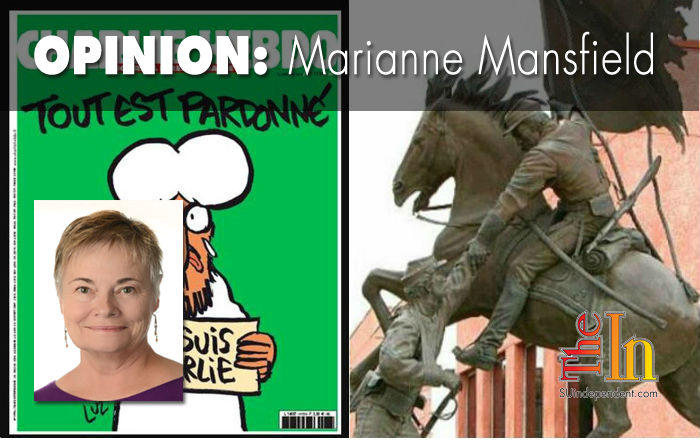
Written by Marianne Mansfield
Is there a boundary between free speech and sensible decency? And, if the boundary exists, is it commonly recognized? Or do the two concepts bleed into each other, obscuring the distinction between them? When watercolors run together, they often produce a color of sorts that artists refer to as mud, for obvious reasons. When free speech bleeds into decency, or vice versa, what results in the best case scenario is mud. In the worst case? A lethal quagmire of pain, anger and revenge.Consider the actions, post the terrorist attack, of the remaining staff of the French satirical magazine Charlie Hebdo. They produced a magazine cover once again depicting the Prophet Muhammad, this time crying and holding a sign that read Je Suis Charlie
Wow. They didn’t give in. They stood strong. I want to stand on my rooftop and wave a flag supporting their bravery. But…what is their point? Are they proclaiming that even a terrorist attack that took 12 lives including several of their colleagues is not enough to make them stand down? Or, are they holding strong the front lines of the battle between terrorist ideology and the tenets of democracy? Or are they simply declaring that their commitment to their craft is so indomitable that they are willing to flaunt it in the face of the enemies sworn to silence them? I suppose the only way to answer those questions is to ask the remaining staff members.
I, however, find myself wondering if it is worth it. And I wish I didn’t. I can’t persuade myself, however, that fighting bullets with satire makes sense in the long run. Who wins in these confrontations? Do the terrorists win because they have avowed their loyal reverence to the Prophet Muhammad at the expense of the loss of human life? Is life that expendable to them? Or do the journalists win? Do they win because they have jumped from the trenches and flaunted the advancing troops sworn to wipe them from the face of the earth.
Or maybe, the two sides have bled together (and yes, I intended that) and created a deadly quagmire.
I remember a game we used to play as kids. Two of us would take hold of the two ends of a rope, the length of which had been determined to allow us to be within arms distance of one another. The challenge was to hit your opponent as many times as you could while enduring the blows your opponent landed on you. You had to keep hold of your end of the rope to stay in the game.
The stand-off between free speech and sensible decency feels a bit like that game must have looked. Silly, stupid and dangerous. Back then we sustained a few bruises and skinned knees. The stakes are inestimably higher when human life is the consequence.
But, lest we rest fitfully in our own complacency, assuming that the questions I ponder are relevant only to the action on the world stage, let’s consider this.
I awoke this morning to the news that the Dixie Rebels statue had found its way back to its creator, artist Jerry Anderson. In this case an inanimate statue, an albeit impressive work of art, represents the tug of war between free speech and sensible decency.
The nuances of why the depiction of the Confederate flag was essential to the substance of the sculpture are not mine to explain. Because I can’t. I do, however, understand and agree with those voices that rose up in 2012 to protest the presence of a flag associated with one of our country’s most shameful moments as it tore itself apart over the support of human slavery.
To be fair, that probably isn’t what the artist had in mind, nor was it what many who cherished the historical influence Dixie College had exerted over their lives and the growth of the community saw when they viewed the statue.
But it was what a number of us saw, and felt and heard.
So, once again, we have free speech, in this case expressed in a work of art, facing off against common decency in the form of repugnance at the representation of evil.
My first reaction to the deal that was struck between DSU officials and the creator of the statue, to return it to him in exchange for other pieces of artwork was that it was not a bad compromise. Compromise is mostly messy, and seldom completely satisfying, but allows both sides to savor partial victory. So, okay. I can live with it.
But then, I can’t. Human slavery is still abominable, as awful as the murder of innocent journalists, no matter how tasteless their work.
Mohandas K. Gandhi said of compromise:
“All compromise is based on give and take, but there can be no give and take on fundamentals. Any compromise on mere fundamentals is a surrender. For it is all give and no take.”
Fundamentals, to me, begin and end with how we value human life. If I view the two instances above through that lens, Charlie Hebdo should continue to offend whomever it can, and the Dixie Rebels statue should remain as far away from a campus of higher education as possible.
Related Stories: Charlie Hebdo presses on and so will we
The Dixie Rebels statue will rise again
When violence tries to silence
Marianne Mansfield has lived in Southern Utah since 2010. She and her husband followed their grandchildren to this area from Michigan. In her former life she was a public school educator. More than half of her career was spent as an elementary principal, which is why her response to most challenges is, “This isn’t my first rodeo.” She grew up in Indiana, and attended Miami of Ohio, Ball State University and Michigan State. She is a loyal MSU Spartan and Detroit Tiger baseball fan. She has been writing fiction and opinion since her retirement in 2004.




